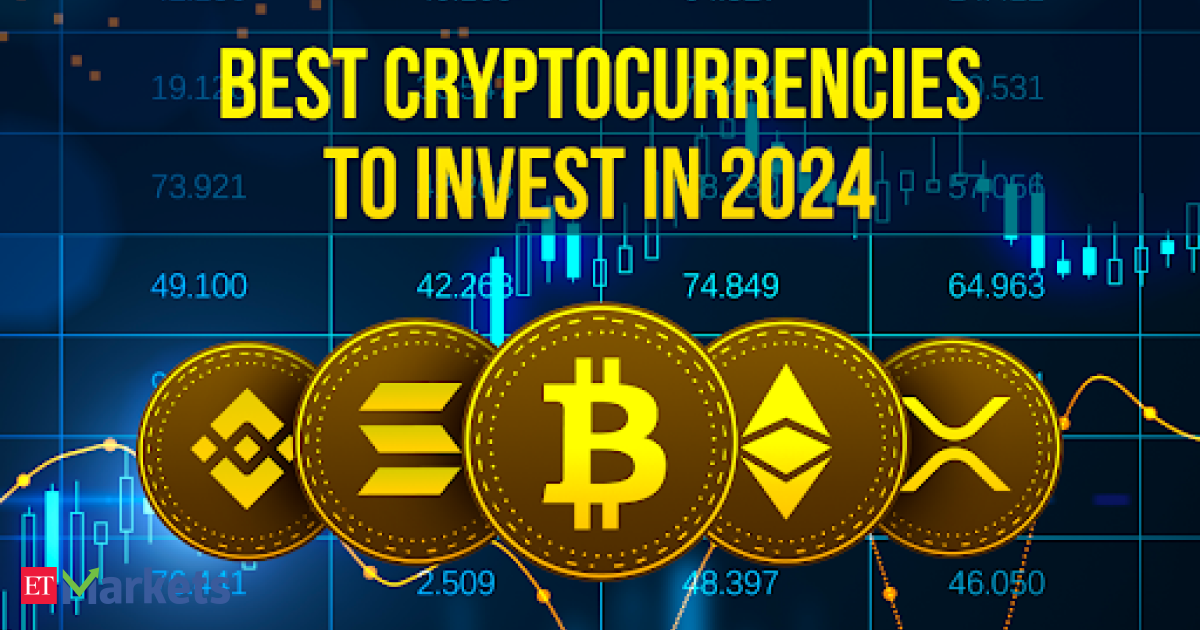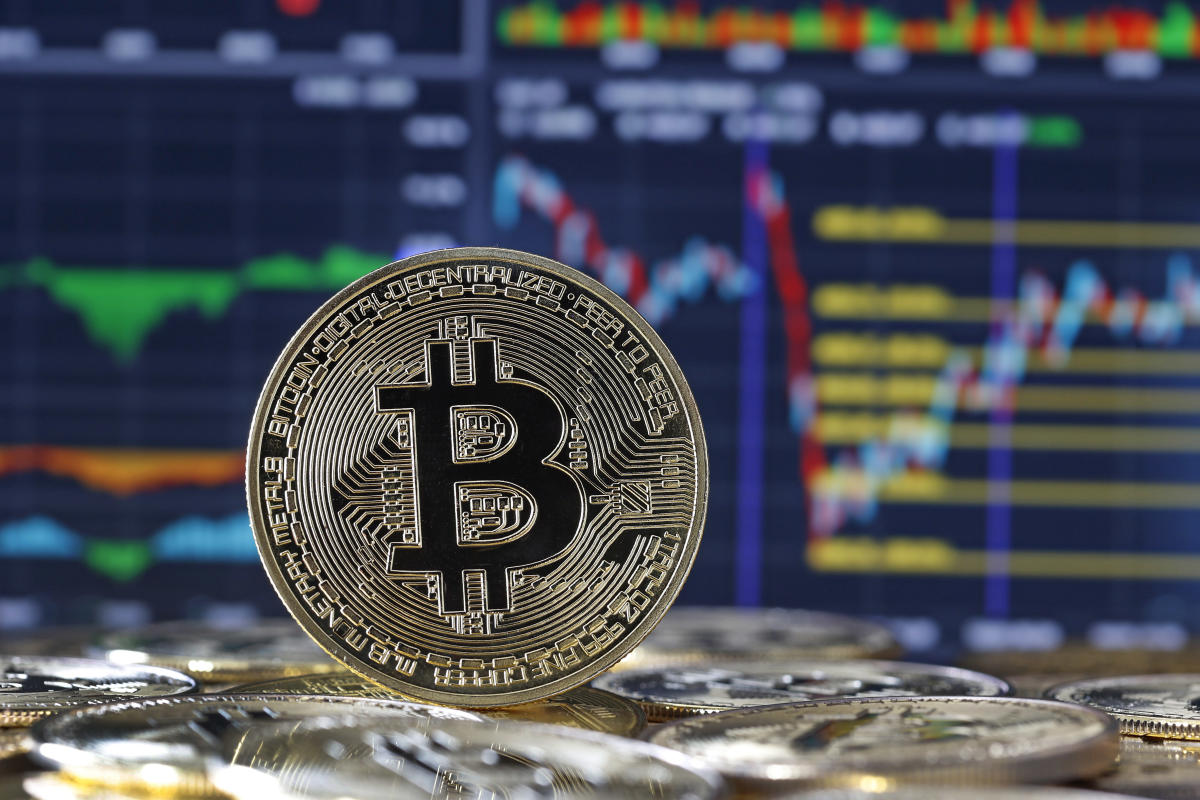News
10 meilleures crypto-monnaies pour investir en juin 2024

Après des montagnes russes en 2023, les choses s’améliorent pour le marché de la cryptographie. La Securities and Exchange Commission (SEC) des États-Unis a récemment approuvé la cotation des ETF au comptant Bitcoin de onze organisations différentes, dont des poids lourds comme BlackRock et Fidelity.
L’approbation de la SEC a naturellement suscité la curiosité des investisseurs particuliers à l’égard des crypto-monnaies. Ils se demandent désormais : « Dans quoi dois-je investir ? Cet article examine les dix crypto-monnaies les plus prometteuses dans lesquelles investir en 2024. Des titans établis comme Bitcoin et Ether seront les piliers du portefeuille. Mais des étoiles montantes comme Solana et Injective se disputent également une part de l’avenir numérique.
Préparez-vous, car 2024 s’annonce comme une année rentable pour les investisseurs en crypto.
Suivi des crypto-monnaies
Principales crypto-monnaies dans lesquelles investir en 2024
Nous examinons ci-dessous les principales pièces et jetons dans lesquels investir en 2024.Bitcoin (BTC)
La première crypto-monnaie au monde, Bitcoin, possède la plus grande capitalisation boursière. Son réseau établi, son offre limitée et son adoption institutionnelle croissante en font un refuge relativement sûr sur le marché volatil de la cryptographie. Le Bitcoin a augmenté de 155 % entre le début et la fin de 2023. Ces rendements sont meilleurs que tout ce que vous obtiendriez en investissant dans actifs financiers traditionnels, mais avec un risque légèrement plus élevé. Avec l’approbation imminente de l’ETF, la réduction de moitié et les baisses potentielles de taux de la Fed américaine, Bitcoin est sur le point d’atteindre de plus hauts sommets en 2024.Achetez du Bitcoin maintenantEthereum (ETH)
Plateforme incontournable pour les contrats intelligents et les dApps, Ethereum alimente le domaine en plein essor de la finance décentralisée (DeFi). Malgré la concurrence intense des autres blockchains de couche 1, de nombreux investisseurs institutionnels s’appuient sur Ethereum en raison de sa sécurité et de son écosystème mature.
En raison de cet intérêt des institutions, nous pensons que c’est un excellent atout pour le HODLing. La prochaine proposition EIP-4844 pourrait réduire considérablement les frais de gaz sur les blockchains de couche 2 s’appuyant sur Ethereum. Ce serait une autre victoire pour Ethereum et pourrait encore augmenter sa valeur.
Achetez de l’Ethereum maintenant
Solana (SOL)Bénéficiant de vitesses de transaction ultra-rapides et de frais peu élevés, Solana a attiré un écosystème florissant de projets DeFi et NFT. Son accent continu sur l’évolutivité et l’expérience des développeurs en fait un concurrent sérieux dans le domaine de la blockchain haute performance.
Selon les données du fournisseur de données cryptographiques CryptoSlam, les ventes de NFT sur la blockchain Solana (366,5 millions de dollars) ont dépassé celles d’Ethereum (353,2 millions de dollars) pour la première fois en décembre 2023. Cela explique le fort intérêt des utilisateurs particuliers pour Solana.
Cardano (ADA)Construit grâce à des recherches méticuleuses, Cardano dispose d’une blockchain sécurisée et évolutive. L’accent mis sur la durabilité et les contrats intelligents en fait un acteur de long terme engagé en faveur d’une croissance responsable.
ADA n’est pas seulement un actif spéculatif. Les gens l’explorent pour diverses applications du monde réel, notamment la gestion de la chaîne d’approvisionnement, la vérification d’identité et les systèmes de vote. Ces cas d’utilisation réels confèrent une valeur ADA, ce qui en fait un excellent ajout aux portefeuilles cryptographiques.
Polygone (MATIC)Polygon est une solution de mise à l’échelle de couche 2 populaire pour Ethereum, ce qui signifie qu’elle aide les transactions sur la blockchain Ethereum à devenir considérablement plus rapides et moins chères.
D’autres solutions de mise à l’échelle de couche 2 ont émergé depuis les débuts de Polygon en octobre 2017, mais elles restent une option populaire dans DeFi. Plusieurs dApps populaires comme Uniswap, Curve, Chainlink et bien d’autres ont intégré Polygon dans leurs écosystèmes.
À l’avenir, Polygon vise à proposer ses solutions de mise à l’échelle à d’autres blockchains. Il prévoit également d’assurer l’interopérabilité entre les différents protocoles et blockchains.
En raison du succès de Polygon et de ses objectifs de résoudre des problèmes du monde réel, MATIC est une excellente pièce dans laquelle investir.
Avalanche (AVAX)
Avalanche (AVAX) gagne en popularité en défiant Ethereum avec ses transactions ultra-rapides. En 2023, il a augmenté de 254 %, malgré les hauts et les bas du marché. La croissance constante provient de son écosystème en expansion, de ses nouvelles dApps et de ses partenariats. Avec des frais faibles et une évolutivité, il attire les utilisateurs et les développeurs à la recherche d’une option plus rapide et moins chère qu’Ethereum.
À l’avenir, Avalanche vise les DeFi, les NFT et les solutions commerciales. Avec une équipe et une communauté solides, 2024 semble prometteuse pour AVAX. S’il s’empare d’une part importante dans la DeFi et les NFT, AVAX pourrait devenir un acteur majeur dans le monde de la blockchain.
À pois (POINT)Considérez Polkadot (DOT) comme Internet pour les blockchains. Il connecte différentes blockchains, leur permettant de partager des données et de travailler ensemble. Cette approche « multichaîne » élimine les barrières et ouvre de nouvelles possibilités.
Même si 2023 n’a pas été une année de croissance record pour le DOT, son potentiel pour l’avenir est énorme. Les développeurs peuvent créer des blockchains personnalisées sur Polkadot, ce qui la rend idéale pour tout, de la DeFi aux soins de santé.
De plus, la sécurité est une priorité absolue. La chaîne centrale de Polkadot garde tout sain et sauf.
Avec l’essor de la DeFi et le retour des NFT, l’interopérabilité de Polkadot pourrait être la clé de leur succès.
Injectif (INJ)
Cette blockchain de couche 1 s’adresse à toutes sortes d’applications DeFi, y compris les échanges décentralisés (DEX), les marchés de prédiction et les protocoles de prêt, le tout en chaîne et ultra-rapide. Comme Ethereum, il offre un excellent support pour les contrats intelligents.
Injective fournit des modules plug-and-play que les développeurs peuvent utiliser pour créer des applications financières de pointe. Son jeton, INJ, alimente la plateforme, vous permettant de voter sur les mises à niveau et potentiellement de partager sa croissance.
Le prix de l’INJ est monté en flèche vers la fin de 2023, passant d’environ 8 $ début octobre à environ 40 $ à la fin de l’année, soit une croissance massive de 5 fois ! Dans l’ensemble, les choses s’annoncent prometteuses pour Injective en 2024.
Uniswap (UNI)
Uniswap (UNI) est un échange décentralisé (DEX) où vous pouvez négocier directement depuis votre propre portefeuille. Contrairement à une bourse centralisée (CEX) comme Binance, vous gardez le contrôle total de vos fonds, il n’y a donc aucun risque que vos actifs soient gelés.
En tant que DEX, Uniswap n’utilise pas non plus le modèle traditionnel du carnet de commandes. Au lieu de cela, il facilite l’échange de jetons peer-to-peer. Cela signifie que les utilisateurs peuvent négocier directement entre eux, éliminant ainsi les intermédiaires et réduisant les frais de négociation.
UNI est le token natif de la plateforme et permet aux utilisateurs d’avoir leur mot à dire sur l’évolution d’Uniswap. Ils peuvent voter sur les modifications proposées au protocole, ce qui peut avoir un impact important sur l’avenir de la plateforme.
Cosmos (ATOME)Cosmos est unique dans la mesure où il est conçu pour connecter plusieurs blockchains afin de communiquer de manière transparente.
Son potentiel d’adoption grand public est élevé, faisant de son jeton natif (ATOM) un ajout précieux aux portefeuilles cryptographiques en 2024.
La meilleure façon d’investir dans les Altcoins
Bien que vous puissiez investir individuellement dans vos crypto-monnaies préférées, une meilleure approche consiste à investir dans la crypto en tant que fonds indiciel. Et les jeux de pièces de Mudrex vous permettent de faire exactement cela.
Les jeux de pièces sont des collections organisées de crypto-monnaies regroupées en fonction de thèmes ou sous forme de fonds indiciels. Vous gérez mieux votre risque en investissant dans un panier de crypto-monnaies plutôt qu’en sélectionnant manuellement des pièces individuelles. Les gains sur d’autres actifs peuvent compenser une baisse d’un actif individuel.
À titre d’exemple, prenons le Crypto de Mudrex Ensemble de pièces Blue Chip. Il s’agit d’un fonds indiciel crypto qui suit les performances des 5 principales crypto-monnaies par capitalisation boursière. Si vous souhaitez une exposition plus large sans avoir à compter sur des poids lourds comme Bitcoin et Ethereum, vous voudrez peut-être consulter le Indice large du marché des cryptomonnaies plutôt.
Nos critères de sélection
Investir dans les crypto-monnaies nécessite une réflexion approfondie, au-delà du simple battage médiatique. Pour prendre des décisions éclairées sur les domaines dans lesquels investir, concentrez-vous sur ces cinq critères clés :
Technologie
Plongez au cœur de la technologie blockchain qui sous-tend la crypto-monnaie. Évaluez son évolutivité, sa sécurité, sa décentralisation et son potentiel d’innovation. Existe-t-il des mécanismes uniques qui répondent aux défis actuels de la blockchain ? Offre-t-il une interopérabilité avec d’autres plateformes ?
L’évaluation de la technologie permet d’évaluer le potentiel de croissance et d’adoption futures de la crypto-monnaie.
Équipe
Examinez l’équipe derrière le projet. Ont-ils une expertise et une expérience pertinentes dans le développement et les affaires de la blockchain ? Leur parcours est-il transparent et crédible ? Sont-ils activement engagés dans la communauté et sensibles aux commentaires ?
Utilitaire
Un cas d’utilisation convaincant est essentiel. La crypto-monnaie résout-elle un problème du monde réel ou offre-t-elle une proposition de valeur claire ? Comment se différencie-t-elle des solutions existantes ? Existe-t-il une demande soutenue pour ses fonctionnalités au sein de son marché cible ?
Si une crypto-monnaie a un ou deux cas d’utilisation pratique, elle a plus de chances de réussir et d’avoir une valeur à long terme.
Demande du marché
Analysez la demande du marché et le taux d’adoption de la crypto-monnaie. Existe-t-il une base d’utilisateurs et une communauté de développeurs croissantes ? Les institutions ou les entreprises établies adoptent-elles son utilisation ? Son volume de transactions et sa liquidité ont-ils augmenté régulièrement ?
Performance récente du marché
Même si les performances passées ne préjugent pas des résultats futurs, les mouvements de prix historiques peuvent offrir des informations précieuses. Comprendre les facteurs qui déterminent les fluctuations des prix à court et à long terme. Méfiez-vous de la volatilité extrême et des pics soudains, car ils peuvent suggérer un battage spéculatif plutôt qu’une croissance durable.
En étudiant ces cinq critères, vous pouvez mieux comprendre le potentiel d’une crypto-monnaie et prendre des décisions d’investissement éclairées en fonction de ses forces et faiblesses individuelles. N’oubliez pas qu’une recherche approfondie, un portefeuille diversifié et une gestion des risques sont cruciaux dans le monde de la cryptographie.
Comprendre les risques et les considérations
L’investissement en crypto-monnaie présente à la fois des opportunités intéressantes et des risques inhérents. Même si le potentiel de rendements élevés peut être séduisant, vous devez comprendre les risques de ce nouveau marché. Vous trouverez ci-dessous quelques risques et considérations à prendre en compte avant de commencer votre parcours d’investissement :
Volatilité
Contrairement aux actifs traditionnels, les cryptomonnaies connaissent des fluctuations de prix importantes. Ces fluctuations sont souvent caractérisées par des hausses rapides et des baisses tout aussi rapides. Par exemple, le prix du Bitcoin a chuté de près de 3 000 dollars le 3 janvier, et aucune nouvelle importante n’aurait pu en être la cause !
Cette volatilité inhérente comporte un risque de perte important. Nous ne pouvons que souligner la nécessité d’une gestion des risques et de stratégies d’investissement responsables.
Paysage réglementaire
Le cadre réglementaire indien entourant les crypto-monnaies reste en évolution. Ceci malgré le fait que les investisseurs en cryptographie ont déclaré leurs impôts pour la première fois au cours de l’exercice dernier. Cet environnement dynamique peut donner lieu à des perturbations et à des incertitudes, ce qui signifie que vous devez rester informé de l’évolution des réglementations et de leur impact potentiel sur le marché.
Risques technologiques
La technologie Blockchain, bien qu’innovante, connaît encore un développement important. Les imperfections technologiques, les bugs et les vulnérabilités peuvent entraîner des perturbations du réseau, des retards de transaction et même des failles de sécurité. Ces risques peuvent mettre en péril la valeur et la fonctionnalité des actifs investis.
Fraude et escroqueries
Là où il y a de l’argent à gagner, il y aura toujours des acteurs malveillants qui chercheront à exploiter les crédules. Et le monde des crypto-monnaies n’est pas différent. Les escroqueries par phishing sophistiquées, les projets frauduleux, les systèmes de pompage et de vidage et les échanges non réglementés constituent des menaces importantes pour les investisseurs imprudents.
Conclusion
L’année 2024 dresse un tableau dynamique pour les passionnés de cryptographie. Avec la confluence de signaux haussiers tels que l’approbation de l’ETF Bitcoin, la réduction de moitié du Bitcoin et les réductions potentielles des taux de la Fed, nous pourrions assister à une croissance explosive cette année.
Il ne s’agit cependant pas d’une exposition personnelle pour Bitcoin. Les altcoins comme Solana, Cardano et Uniswap se taillent leurs propres niches, alimentés par une technologie innovante et des écosystèmes robustes. Pendant ce temps, les plateformes établies comme Ethereum et Avalanche évoluent constamment, consolidant leur position en tant que pierre angulaire des paysages DeFi et NFT.
News
Bitcoin soars above $63,000 as money flows into new US investment products

Bitcoin has surpassed the $63,000 mark for the first time since November 2021. (Chesnot via Getty Images)
Bitcoin has broken above the $63,000 (£49,745) mark for the first time since November 2021, when the digital asset hit its all-time high of over $68,000.
Over the past 24 hours, the value of the largest digital asset by market capitalization has increased by more than 8% to trade at $63,108, at the time of writing.
Learn more: Live Cryptocurrency Prices
The price appreciation was fueled by record inflows into several U.S.-based bitcoin cash exchange-traded funds (ETFs), which were approved in January this year.
A Bitcoin spot ETF is a financial product that investors believe will pave the way for an influx of traditional capital into the cryptocurrency market. Currently, indications are favorable, with fund managers such as BlackRock (BLK) and Franklin Templeton (BEN), after allocating a record $673 million into spot Bitcoin ETFs on Wednesday.
Learn more: Bitcoin’s Success With SEC Fuels Expectations for an Ether Spot ETF
The record allocation surpassed the funds’ first day of launch, when inflows totaled $655 million. BlackRock’s iShares Bitcoin Trust ETF (I BITE) alone attracted a record $612 million yesterday.
Bitcoin Price Prediction
Earlier this week, veteran investor Peter Brandt said that bitcoin could peak at $200,000 by September 2025. “With the push above the upper boundary of the 15-month channel, the target for the current market bull cycle, which is expected to end in August/September 2025, is raised from $120,000 to $200,000,” Brandt said. published on X.
The influx of capital from the traditional financial sphere into Bitcoin spot ETFs is acting as a major price catalyst for the digital asset, but it is not the only one. The consensus among analysts is that the upcoming “bitcoin halving” could continue to drive flows into the bitcoin market.
The Bitcoin halving is an event that occurs roughly every four years and is expected to happen again next April. The halving will reduce the bitcoin reward that miners receive for validating blocks on the blockchain from 6.25 BTC to 3.125 BTC. This could lead to a supply crunch for the digital asset, which could lead to price appreciation.
The story continues
Watch: Bitcoin ETFs set to attract funds from US pension plans, says Standard Chartered analyst | Future Focus
Download the Yahoo Finance app, available for Apple And Android.
News
FRA Strengthens Cryptocurrency Practice with New Director Thomas Hyun

Forensic Risk Alliance (FRA), an independent consultancy specializing in regulatory investigations, compliance and litigation, has welcomed U.S.-based cryptocurrency specialist Thomas Hyun as a director of the firm’s global cryptocurrency investigations and compliance practice. Hyun brings to the firm years of experience building and leading anti-money laundering (AML) compliance programs, including emerging payment technologies in the blockchain and digital asset ecosystem.
Hyun has nearly 15 years of experience as a compliance officer. Prior to joining FRA, he served as Director of AML and Blockchain Strategy at PayPal for four years. He established PayPal’s financial crime policy and control framework for its cryptocurrency-related products, including PayPal’s first consumer-facing cryptocurrency offering on PayPal and Venmo, as well as PayPal’s branded stablecoin.
At PayPal, Hyun oversaw the second-line AML program for the cryptocurrency business. His responsibilities included drafting financial crime policies supporting the cryptocurrency business, establishing governance and escalation processes for high-risk partners, providing credible challenge and oversight of front-line program areas, and reporting to the Board and associated authorized committees on program performance.
Prior to joining PayPal, Hyun served as Chief Compliance Officer and Bank Secrecy Officer (BSA) at Paxos, a global blockchain infrastructure company. At Paxos, he was responsible for implementing the compliance program, including anti-money laundering and sanctions, around the company’s digital asset exchange and its asset-backed tokens and stablecoins. He also supported the company’s regulatory engagement efforts, securing regulatory approvals, supporting regulatory reviews, and ensuring compliance with relevant digital asset requirements and guidelines.
Thomas brings additional experience in payments and financial crime compliance (FCC), having previously served as Vice President of Compliance at Mastercard, where he was responsible for compliance for its consumer products portfolio. He also spent more than seven years in EY’s forensics practice, working on various FCC investigations for U.S. and foreign financial institutions.
Hyun is a Certified Anti-Money Laundering Specialist (CAMS) and a Certified Fraud Examiner (CFE). He is a graduate of New York University’s Stern School of Business, where he earned a bachelor’s degree in finance and accounting. Additionally, he serves on the board of directors for the Central Ohio Association of Certified Anti-Money Laundering Specialists (ACAMS) chapter.
Commenting on his appointment, Hyun said, “With my experience overseeing and implementing effective compliance programs at various levels of maturity and growth, whether in a startup environment or large enterprises, I am excited to help our clients overcome similar obstacles and challenges to improve their financial crime compliance programs. I am excited to join FRA and leverage my experience to help clients navigate the complexities of AML compliance and financial crime prevention in this dynamic space.”
FRA Partner, Roy Pollittadded: “As the FRA’s sponsor partner for our growing Cryptocurrency Investigations and Compliance practice, I am thrilled to have Thomas join our ever-expanding team. The rapid evolution of blockchain and digital asset technologies presents both exciting opportunities and significant compliance challenges. Hiring Thomas in a leadership role underscores our commitment to staying at the forefront of the industry by enhancing our expertise in anti-money laundering and blockchain strategy.”
“Thomas’ extensive background in financial crime compliance and proven track record of building risk-based FCC programs in the blockchain and digital asset space will be invaluable as we continue to provide our clients with the highest level of service and innovative solutions.”
“FRA strengthens cryptocurrency practice with new director Thomas Hyun” was originally created and published by International Accounting Bulletina brand owned by GlobalData.
The information on this website has been included in good faith for general information purposes only. It is not intended to amount to advice on which you should rely, and we make no representations, warranties or assurances, express or implied, as to its accuracy or completeness. You must obtain professional or specialist advice before taking, or refraining from, any action on the basis of the content on our website.
News
Bitcoin trades around $57,000, crypto market drops 6% ahead of Fed decision

-
Bitcoin fell in line with the broader cryptocurrency market, with ether and other altcoins also falling.
-
Financial markets were weighed down by risk-off sentiment ahead of the Fed’s interest rate decision and press conference later in the day.
-
10x Research said it is targeting a price target of $52,000 to $55,000, anticipating further selling pressure.
Bitcoin {{BTC}} was trading around $57,700 during European morning trading on Wednesday after falling to its lowest level since late February, as the world’s largest cryptocurrency recorded its worst month since November 2022.
BTC has fallen about 6.3% over the past 24 hours, after breaking below the $60,000 support level late Tuesday, according to data from CoinDesk. The broader crypto market, as measured by the CoinDesk 20 Index (CD20), lost nearly 9% before recovering part of its decline.
Cryptocurrencies have been hurt by risk-off sentiment in broader financial markets amid stagflation in the United States, following indications of slowing growth and persistent inflation that have dampened hopes of an interest rate cut by the Federal Reserve. The Federal Open Market Committee is due to deliver its latest rate decision later in the day.
Ether {{ETH}} fell about 5%, dropping below $3,000, while dogecoin {{DOGE}} led the decline among other major altcoins with a 9% drop. Solana {{SOL}} and Avalanche {{AVAX}} both lost about 6%.
Bitcoin plunged in April, posting its first monthly loss since August. The 16% drop is the worst since November 2022, when cryptocurrency exchange FTX imploded, but some analysts are warning of further declines in the immediate future.
10x Research, a digital asset research firm, said it sees selling pressure toward the $52,000 level due to outflows from U.S. cash exchange-traded funds, which have totaled $540 million since the Bitcoin halving on April 20. It estimates that the average entry price for U.S. Bitcoin ETF holders is $57,300, so this could prove to be a key support level.
The closer the bitcoin spot price is to this average entry price, the greater the likelihood of a new ETF unwind, 10x CEO Markus Thielen wrote Wednesday.
“There may have been a lot of ‘TradeFi’ tourists in crypto – pushing longs all the way to the halving – that period is now over,” he wrote. “We expect more unwinding as the average Bitcoin ETF buyer will be underwater when Bitcoin trades below $57,300. This will likely push prices down to our target levels and cause a -25% to -29% correction from the $73,000 high – hence our $52,000/$55,000 price target over the past three weeks.”
The story continues
UPDATE (May 1, 8:56 UTC): Price updates throughout the process.
UPDATE (May 1, 9:57 UTC): Price updates throughout the process.
UPDATE (May 1, 11:05 UTC): Adds analysis from 10x.
News
The Cryptocurrency Industry Is Getting Back on Its Feet, for Better or Worse

Hello from Austin, where thousands of crypto enthusiasts braved storms and scorching heat to attend Consensus. The industry’s largest and longest-running conference, which can sometimes feel like a religious revival, offers opportunities to chat and listen to leading names in crypto. And for the casual observer, Consensus offers a useful glimpse into the mood of an industry prone to wild swings in fortune.
Unsurprisingly, the mood is noticeably more positive than it was a year ago, when crowds were sparse and many attendees were quietly confiding that they were considering switching to AI. In practice, that means some of the more obnoxious elements are back, but not to the level of Consensus 2018 in New York, when charlatans parked Lamborghinis outside the event and the hallways were lined with booth girls and scammers pitching “ICOs in a box.”
This time around, Elon Musk’s Cybertrucks have replaced Lamborghinis as the vehicle of choice for marketers. One of the most notable publicity stunts was a startup that paid a poor guy to parade around in the Texas sun in a Jamie Dimon costume, wig, and mask, and then staged a mock assault on him by memecoin characters.
Outside the event was a giant “RFK for President” truck, while campaign staffers manned a booth instead — a reflection of both the election year and crypto’s willingness to latch onto any candidate, no matter how outlandish, who will talk about the industry. RFK himself is scheduled to address the conference on Thursday.
Excesses aside, the general sense of optimism was understandable. The cryptocurrency market has not only recovered from the wave of fraud that nearly sank it in 2022, it is riding a new wave of political legitimacy. This month, cryptocurrencies scored once-unthinkable political victories in Washington, D.C., and there is a sense that the industry has not only withstood the relentless regulatory assaults of SEC Chairman Gary Gensler and Sen. Elizabeth Warren, but is poised to defeat them.
And while cryptocurrency is still searching for its flagship application, the optimists I spoke with pointed to signs that it is (once again) upon us. Those signs include the rapid advancement of zero-knowledge proofs as well as the popularity of Coinbase’s Base blockchain and, perhaps most importantly, the large-scale arrival of traditional finance into the world of cryptocurrencies – a development that not only provides a major financial boost, but also a new element of stability and maturity that will, perhaps, tame the worst of crypto’s wilder side. Finally, this consensus marked the end of the Austin era as the conference, under new leadership, will be held in Toronto and Hong Kong in 2025.
The story continues
Jeff John Roberts
jeff.roberts@fortune.com
@jeffjohnroberts
This story was originally featured on Fortune.com
-

 News12 months ago
News12 months agoBitcoin soars above $63,000 as money flows into new US investment products
-

 DeFi12 months ago
DeFi12 months agoEthena downplays danger of letting traders use USDe to back risky bets – DL News
-

 News12 months ago
News12 months agoFRA Strengthens Cryptocurrency Practice with New Director Thomas Hyun
-

 DeFi12 months ago
DeFi12 months agoZodialtd.com to revolutionize derivatives trading with WEB3 technology
-

 Markets12 months ago
Markets12 months agoBitcoin Fails to Recover from Dovish FOMC Meeting: Why?
-

 DeFi1 year ago
DeFi1 year ago👀 Lido prepares its response to the recovery boom
-

 Markets1 year ago
Markets1 year agoWhy Bitcoin’s price of $100,000 could be closer than ever ⋆ ZyCrypto
-

 Markets1 year ago
Markets1 year agoWhale Investments in Bitcoin Reached $100 Billion in 2024, Fueling Crazy Investor Optimism ⋆ ZyCrypto
-

 DeFi1 year ago
DeFi1 year agoPancakeSwap integrates Zyfi for transparent, gas-free DeFi
-

 DeFi1 year ago
DeFi1 year ago🏴☠️ Pump.Fun operated by Insider Exploit
-

 Markets1 year ago
Markets1 year agoa resilient industry that defies market turbulence
-

 DeFi1 year ago
DeFi1 year ago👀SEC Receives Updated Spot Ether ETF Filings







